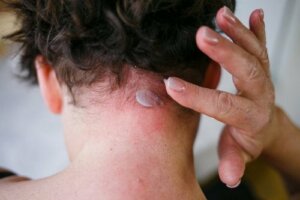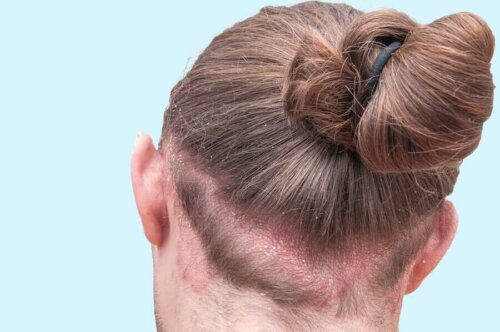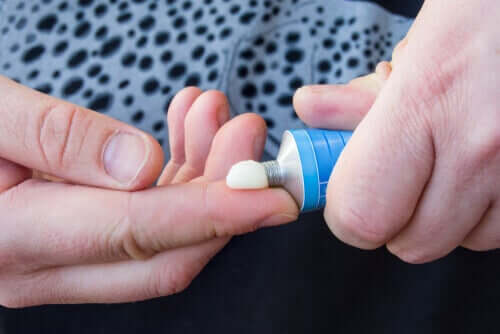Symptoms of Seborrheic Dermatitis and Treatment

Today’s article will discuss the causes and symptoms of seborrheic dermatitis, a common skin condition. It’s a type of eczema that’s not triggered by external factors and mainly affects the scalp. However, it can also affect other areas such as the face, fins of the nose, eyebrows, ears, eyelids, and the chest.
Seborrheic dermatitis can occur in both adults and infants. It usually appears in stages of life when there’s a greater sebaceous activity linked to a greater hormonal stimulus.
Causes of seborrheic dermatitis
The exact cause of seborrheic dermatitis is currently unknown. However, its appearance may be related to the Malassezia fungus found in the sebaceous secretion in the skin. Another cause of seborrheic dermatitis may be an irregular immune system response.
There are a number of factors that can increase the risk of developing seborrheic dermatitis, including neurological and psychiatric disorders. There’s also an increased risk in those with a weakened immune system — such as that of organ transplant recipients and people with HIV.

Symptoms of seborrheic dermatitis
Symptoms of seborrheic dermatitis include dandruff, skin lesions, itching, and mild erythema and manifest as small scales on the scalp.
The skin peeling is also frequent in eyebrows, eyelashes, beard hair, and the upper lip. Also, in the nasolabial furrow and the back of the ears.
Furthermore, there’s inflammation in the eyelids in some patients and small scabs form on the edge of their eyelids as well. At the trunk level, seborrheic dermatitis manifests as rounded erythematous plaques. Sometimes covered by rather adherent scales, resembling psoriasis lesions.
Read about The Differences between Atopic and Seborrheic Dermatitis
Diagnosis
The diagnosis depends on the appearance and location of the skin lesions. Patches with oily scales on the scalp are characteristic of seborrheic dermatitis.
In addition, erythematous flaking lesions are usually present in the areas of insertion of the scalp such as the retro-auricular folds, nasogenian folds, or eyebrows. The characteristic lesion in babies is cradle cap.
Physicians should make a differential diagnosis of seborrheic dermatitis with other diseases that present similar symptoms:
- Psoriasis is a condition that also causes dandruff and silvery flaky, scaly skin irritation.
- Atopic dermatitis is a skin condition that causes itching and inflammation in the folds of the elbows, the back of the knees, and the front of the neck.
- Pityriasis Versicolor is a rash on the trunk but it isn’t usually pink like the spots of seborrheic dermatitis.
- Rosacea usually occurs on the face and there are few scales.
Treatments of seborrheic dermatitis
There are several general hygiene measures, such as avoiding extremely hot showers, heated, or air-conditioned environments, and situations of greater emotional stress. Use neutral moisturizing soaps and non-greasy moisturizing creams or lotions in your daily hygiene ritual.

Anti-inflammatories
You can apply corticosteroids such as hydrocortisone, fluocinolone, and clobetasol on the scalp or other affected areas. You can find them as lotions, shampoos, or ointments.
They’re effective and easy to use but you must exercise caution. This is because they could lead to negative side effects when used over a long time period of time — thinning of the skin or spots.
Products containing calcineurin inhibitors such as tacrolimus and pimecrolimus may be effective and have fewer side effects than corticosteroids. However, they’re not first-choice treatments.
Do you know: What’s Atopic Dermatitis?
Antifungals can relieve the symptoms of seborrheic dermatitis
These are available as gels, creams, and shampoos and you can alternate them with other medications. They may contain 1% or 2% ketoconazole – select them according to the intensity of the condition and the area you’d like to treat.
Also, there are oral treatments with tetracyclines for more severe cases as these can decrease sebaceous secretion. In general, the response to treatment of seborrheic dermatitis is good.
However, you should know that you’ll still require maintenance treatment. This is because the disease can linger for months and even years. Nevertheless, there’ll be outbreaks and these will improve in the warmer seasons. Unfortunately, they’ll get worse in the cold months and throughout situations of fatigue and emotional stress.
All cited sources were thoroughly reviewed by our team to ensure their quality, reliability, currency, and validity. The bibliography of this article was considered reliable and of academic or scientific accuracy.
- Berk T, Scheinfeld N. Seborrheic dermatitis. P T. 2010;35(6):348–352.
- Borda LJ, Wikramanayake TC. Seborrheic Dermatitis and Dandruff: A Comprehensive Review. J Clin Investig Dermatol. 2015;3(2):10.13188/2373-1044.1000019. doi:10.13188/2373-1044.1000019.
- Calderón-Komáromy, A., Borbujo, J., & Freites-Martínez, A. (2014). Dermatitis seborreica. FMC Formacion Medica Continuada En Atencion Primaria. https://doi.org/10.1016/S1134-2072(14)70690-5.
- CORREA, B. O. (1950). Dermatitis seborreica. Consideraciones etiopatogenicas. Revista Chilena de Pediatr??A.
- Quintanilla Santamaría, M., Zambrano Centeno, B., & Alonso Pacheco, M. L. (2013). Dermatitis seborreica en el adulto. SEMERGEN – Medicina de Familia. https://doi.org/10.1016/s1138-3593(00)73647-1.
This text is provided for informational purposes only and does not replace consultation with a professional. If in doubt, consult your specialist.









